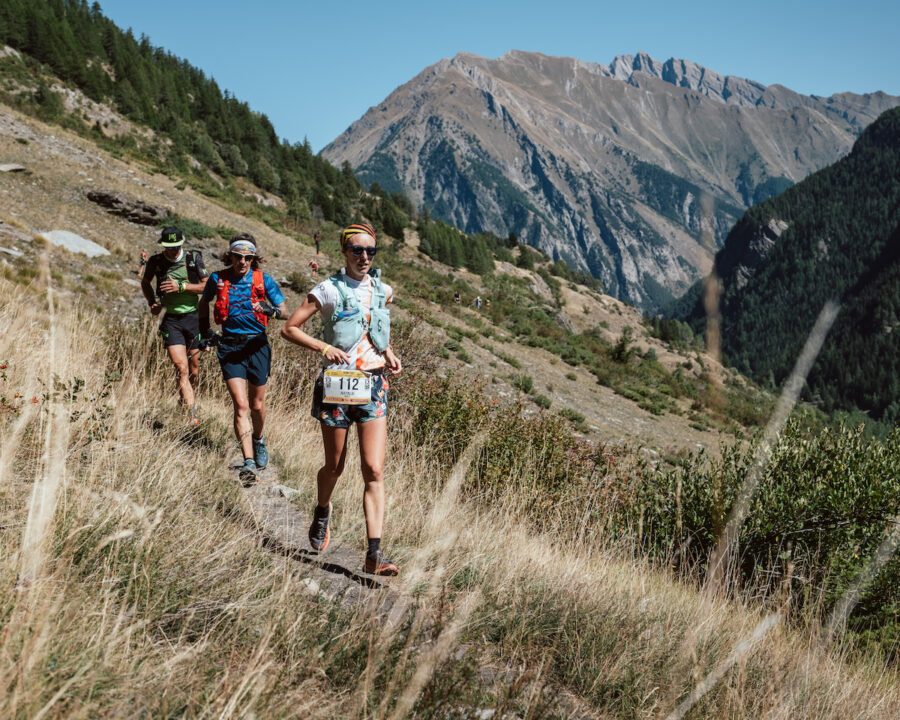
Just like a 5k race, it’s hard to get a 330km race right on a first attempt. Natalie White thinks it takes two or three goes to get it just right.
In the build-up to this year’s Tor des Geants in the Aosta valley, Italy, Kirsty Reade and Natalie White will share their training and preparations in a series of article focused on the race and mountain ultra-running.
As a seasoned runner with two successful completions of the grueling 350km Tor des Geants under my belt, I’ve gained invaluable insights and strategies for training and preparation. This iconic race, which traverses the breathtaking yet brutal terrain of Italy’s Aosta Valley, is not just a test of physical endurance but also of mental fortitude.

We’re not sure if Natalie has previously run GTC or this is a mugshot from a crime committed at the race. Credits: Alessandro Zambianchi and Gran Trail Courmayeur / ZZAM agency
Incorporating Key Races into Training
One of the most effective ways to prepare for the Tor des Geants is to include races that simulate the event’s demanding conditions. The Gran Trail Courmayeur, a 55km race through the rugged Mont Blanc massif, serves just that purpose. They have a 105 and 55k race, in the same valley as the Tor. This year I’ll return to the 55k.
The race offers a microcosm of the challenges faced in the Tor des Geants, with its steep ascents, technical descents, and high-altitude trails. It’s organised by the same people as well, so you get a feel for the race environment, the checkpoints and maybe even a chance to test out a pre-race pizzeria for September.
The GTC also provides an ideal setting to practice race-day nutrition and hydration strategies. During training and in prep races, experiment with different types of nutrition—gels, bars, electrolyte drinks, and real food—to determine what your stomach tolerates best and what keeps your energy levels steady.

Photo: Jack Atkinson
Lessons from Ultra Trail Snowdonia
In my journey, not every race has gone according to plan. A particularly pivotal experience was my attempt at the Ultra Trail Snowdonia. Unfortunately I withdrew at the 80km mark following a fall. Despite not completing the race, this event was a valuable one and, in the long run, I’m sure it’ll make me stronger. Here’s why:
Firstly, the race underscored the importance of being adaptable. In such long races, conditions can change rapidly, and unforeseen obstacles and incidents are part of the job. Learning to adapt your pace, strategy, and mindset on the fly is essential.
Secondly, it reinforced the significance of mental resilience. The disappointment of not finishing can be a powerful motivator, driving a deeper commitment to training and preparation. Mental toughness is built not only through physical training but also by overcoming setbacks and learning to manage pain and fatigue.
Crafting a Comprehensive Training Plan
With this being the third time I’ve prepped for the Tor you’d think the training would be dialled in by now. But every year we grow stronger, new challenges arise and we find new ways to improve.
Working with my coach Robbie (who’s also my husband), we plan out the bigger landmarks along the way. This can be a training trip onto the course in August and build-up races in July. On a shorter scale training is planned weeks to week, reacting to progress and life.
We monitor time and elevation more than distance. Not all kilometres are created equal, and if you’re training for a race with steep, technical ascents and descents, you can’t be running your long runs on flat roads (Kirsty covered that in her article too).
Lastly, the crafting never stops. Week after week, month after month, we need to be able to adapt the plan. Planning months ahead may seem smart, but we can’t see the future and a plan needs to be adaptable by the athlete and the coach. Plus, sometimes you just want to add in an adventure or two.
Practicing Race-Day Fuelling
Effective fuelling is a game-changer in ultra-distance races, especially when they last for multiple days. During my training, I often focus on mimicking race conditions. This includes long runs.
I carry and eat the same nutrition I plan to use during the race itself. It’s not just about what you eat, but also when you eat and how your body and mind responds under different conditions of stress and fatigue.
Sometimes we stop eating as regularly when we’re tired. The more you’ve practiced and built routines to keep the fuel coming in, the more likely you’ll make the right decision in the heat of the battle.
Third times a charm
Training for the Tor des Geants goes beyond just logging miles. It requires planning, adaptability, and learning from every experience—both successful and challenging.
With the lessons learned from past races, such as the GTC55 and Ultra Trail Snowdonia (and two previous Tor des Geants) I’ll be well-equipped to face the extraordinary demands of this epic adventure. Third times a charm anyway.



















